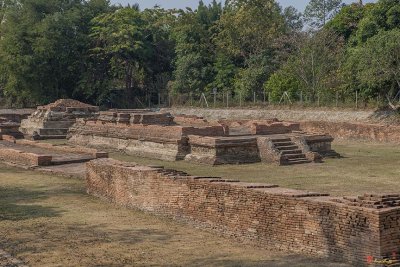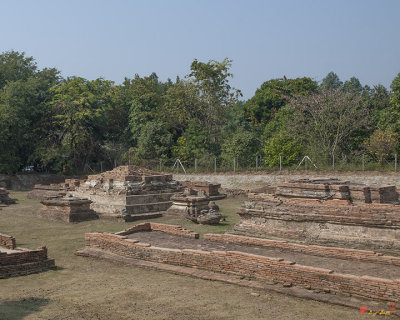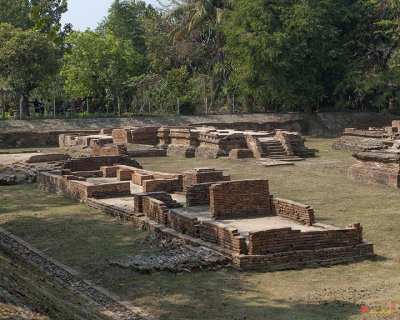





 |
 |
 |
 |
 |
 |
| Gerry Gantt Nature & Scenic Photography | profile | all galleries >> Thailand ประเทศไทย >> Chiang Mai Prov. จังหวัดเชียงใหม่ >> Saraphi District, Chiang Mai Province, Thailand >> Wiang Kum Kam Historic District >> Wat Nan Chang วัดหนานช้ง | tree view | thumbnails | slideshow | map |
, Wiang Kum Kam, Tambon Tha Wang Tan, Saraphi District, Chiang Mai Province, Thailand
Also spelled Wat Nanchang
วัดหนานช้ง เวียงกุมกาม ตำบลท่าวังตาล อำเภอสารภี จังหวัดเชียงใหม่ ประเทศไทย
From an historical marker at the site:
This ancient monument is evidence of flooding at Wiang Kum Kam in the past. The 1.80 meter deep layer of sand and soil sediments were excavated in 2002-2003, revealing ruins of buildings similar to other temples in Wiang Kum Kam. This temple is different in that there were two buildings from two different periods, one on top of the other.
In the earlier period, a portion of the main gate and a wall had been build around a Vihara (Wihan) and a Chedi. In the second period, the grounds of the temple were extend by demolishing the rear wall and constructing more buildings. The excavation team found ruins of a building with a square outline with four arches with a pointed tip. The stairway of this building features Magara (a mythical creature with features partly of crocodile, porpoise and elephant) spouting a Naga's head from its mouth. This building was built on top of the demolished part of the wall from the earlier period. Also in the second period, the wall was extended to enclose all of the buildings.
The temple was called Wat Nanchang to honor the ancestors of the owner of the land. One interesting thing about this temple is that it faces north while other temples face east. It is speculated that it was built to face the now dried-up route of the Ping River, which was a transportation and travel route of the time. Apart from the Magara at the stairway, other beautiful stucco designs of mythical creatures such as a Kilen (a Chinese nixed creature of dragon, deer, cow and horse), Haemarja (a mixed creature of lion and swan) and Singha (a lion). These were found under the middle of the pedestal base of the main Buddha image in the Vihara.
In addition, some Chinese ceramics of the Ming Dynasty (AD 1368-1644) were found. These were divided into two groups. Group one consists of 47 pieces, neatly arranged in a jar and intentionally buried between the building with square structure and other buildings. This might have been because the people needed to escape from the water and later sediments from the flood buried the jar. One among the pieces from this first group of ceramics is a piece from the royal kiln of Emperor Ta Ming Wan Li (1573-1619 AD) whose reign was at the time Chiang Mai was under Burmese rule. The other group of ceramics consists of eight pieces buried in the flood sediments at the area thought to have been the earthen wall against the water north of the temple. These ceramics are evidence of Wiang Kum Kam's relationship with China and gave answers to many historical uncertainties about Wiang Kum Kam.
The temple is dated to around the 16th-17th centuries AD.
โบราณสถานข้างหน้านี้ เป็นตัวอย่างหนึ่งที่บ่งอกร่องรอยของอุทกภัยที่มีผลต่อเวียงกุามในอคีตกาลชั้นตะกอนทร&
 Wat Nan Chang Ruins (DTHCM0791) |
 Wat Nan Chang Wihan Ruins (DTHCM0792) |
 Wat Nan Chang Chedi Ruins (DTHCM0793) |
 Wat Nan Chang Ruins (DTHCM0794) |
| comment | share |